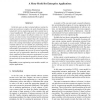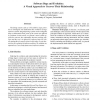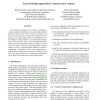SYNASC
2006
IEEE
13 years 10 months ago
2006
IEEE
In the last years, as object-oriented software systems became more and more complex, the need of performing automatically reverse engineering upon these systems has increased sign...
IRI
2006
IEEE
13 years 10 months ago
2006
IEEE
Safeguarding practices for networked systems involves decisions in at least three areas: identification of welldefined security policies, selection of cost-effective defense strat...
ECBS
2006
IEEE
13 years 10 months ago
2006
IEEE
Complex and distributed systems are more and more common. Hardware is going from strength to strength and is embedded in high performance peer-to-peer networks mostly. The task of...
CSMR
2006
IEEE
13 years 10 months ago
2006
IEEE
Versioning systems such as CVS exhibit a large potential to investigate and understand the evolution of large software systems. Bug Reporting systems such as Bugzilla help to unde...
COMPSAC
2006
IEEE
13 years 10 months ago
2006
IEEE
As software systems evolve by adding new extensions some unexpected conflicts may occur, which is known as the Feature Interaction Problem (FIP). FIP is a threat to the dependabil...
VAMOS
2007
Springer
13 years 10 months ago
2007
Springer
The omnipresent integration of computer technology in everyday applications introduces new opportunities to make software systems aware of the context in which they are used. Such...
SOCO
2007
Springer
13 years 10 months ago
2007
Springer
Contemporary software systems are composed of many components, which, in general, undergo phased and incremental development. In order to facilitate the corresponding construction ...
SMALLTALK
2007
Springer
13 years 10 months ago
2007
Springer
While many software systems today have to be aware of the context in which they are executing, there is still little support for structuring a program with respect to context. A ï¬...
SMALLTALK
2007
Springer
13 years 10 months ago
2007
Springer
Real world software systems change continuously to meet new demands. Most programming languages and development environments, however, are more concerned with limiting the effects...
QOSA
2007
Springer
13 years 10 months ago
2007
Springer
: Modern society relies heavily on complex software systems for everyday activities. Dependability of these systems thus has become a critical feature that determines which product...



